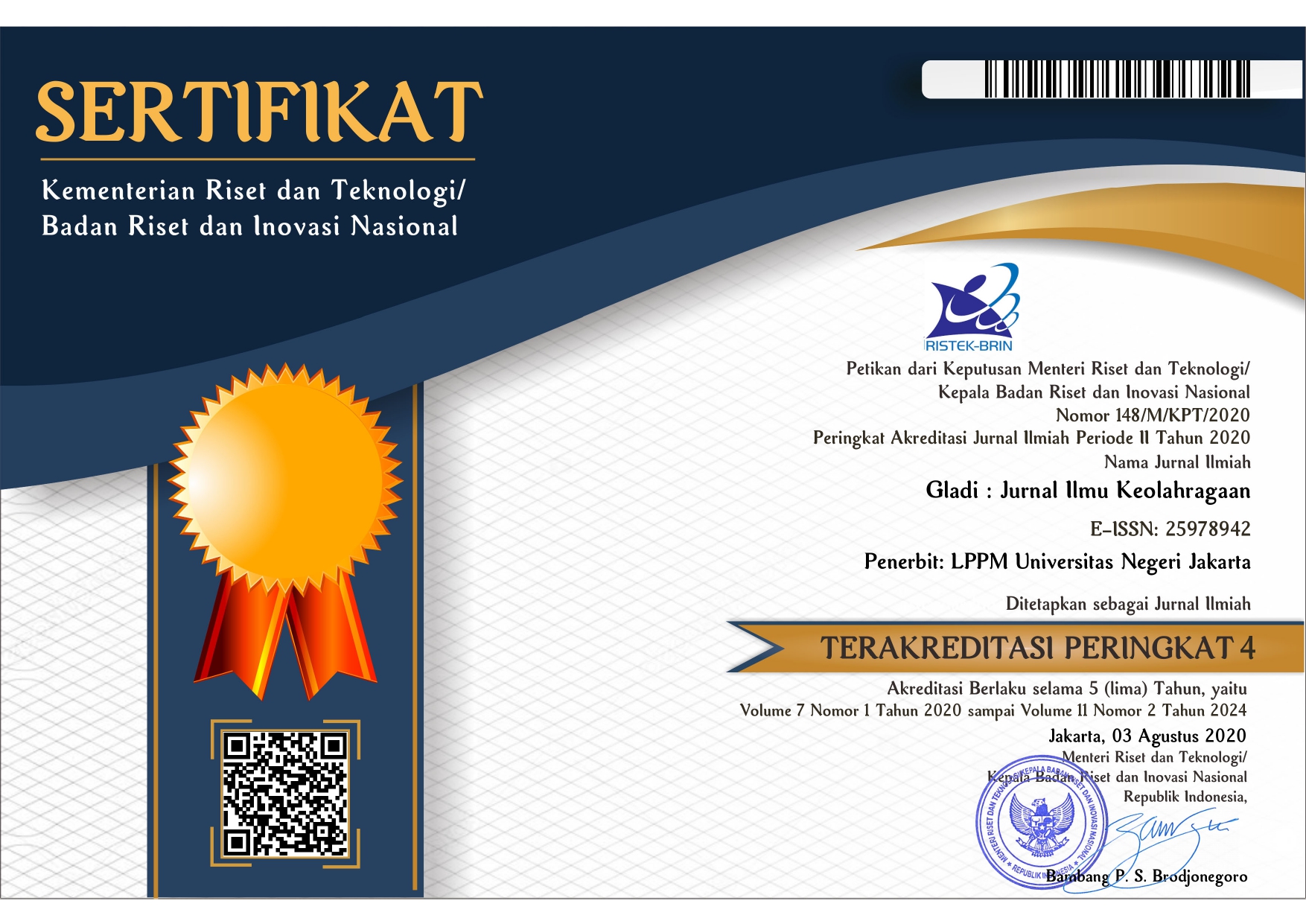Comparative Analysis of the Best Finsswimmers Strategies in the 800 Meter Surface Monofins at the World Championships
Keywords:
finswimming, analysis strategy, performanceAbstract
The use of strategy in competitions is an important aspect in improving an athlete's performance. So it is very important for athletes and coaches to understand this. This research involved 48 finswimming athletes, 24 male athletes, 24 female athletes in the 800 meter surface monofins event at the 2016-2022 World Championships, participants were selected from the best positions 1-8. This research uses secondary data obtained from the CMAS website. The data normality test in this study used Shapirow-wilk. To find out the differences between each round, use the one way ANOVA test. The results of this research show that in the first round, there was a significant time acceleration for female athletes in 2018 with an average time of 24.17 seconds. The time difference between rounds was significant for male athletes in the 2nd to 4th rounds (p < 0.05), while female athletes showed significant time differences in almost all rounds with a value < 0.05. This research concludes that the average male and female athletes in each world championships use a parabola strategy, there is a difference in the average time in each round and there is also a difference in time between male and female athletes
Downloads
References
Aspenes, Stian Thoresen, and Trine Karlsen. 2012. “Exercise-Training Intervention Studies in Competitive Swimming.” Sports Medicine 42(6): 527–43. http://link.springer.com/10.2165/11630760-000000000-00000.
Barbosa, Tiago M. et al. 2010. “Energetics and Biomechanics as Determining Factors of Swimming Performance: Updating the State of the Art.” Journal of Science and Medicine in Sport 13(2): 262–69. https://linkinghub.elsevier.com/retrieve/pii/S1440244009000450.
Barroso, Renato et al. 2023. “Longitudinal Analysis of the 800-m Performances of the World’s Best Female Long-Distance Pool Swimmer: A Case Study Using Critical Speed and D ′.” International Journal of Sports Science & Coaching 18(4): 1307–12. http://journals.sagepub.com/doi/10.1177/17479541221104721.
Costa, Mário J et al. 2010. “Tracking the Performance of World-Ranked Swimmers.” Journal of sports science & medicine 9(3): 411–17. http://www.ncbi.nlm.nih.gov/pubmed/24149635.
Demarie, Sabrina, Jean Renaud Pycke, Alessia Pizzuti, and Veronique Billat. 2023. “Pacing of Human Locomotion on Land and in Water: 1500 m Swimming vs. 5000 m Running.” Applied Sciences 13(11): 6455. https://www.mdpi.com/2076-3417/13/11/6455.
Gabriela, Roberta, and Oliveira Gatti. 2004. “Artigo Original RESPOSTAS FISIOLÓGICAS E BIOMECÂNICAS DE NADADORES EM DIFERENTES INTENSIDADES DE NADO . PHYSIOLOGICAL AND BIOMECHANICAL RESPONSES OF SWIMMERS AT DIFFERENT SWIMMING INTENSITIES .” Revista Brasileira de Cineantropometria e Desempenho Humano 6(1): 26–35.
de Koning, Jos J. et al. 2011. “Using Modeling to Understand How Athletes in Different Disciplines Solve the Same Problem: Swimming Versus Running Versus Speed Skating.” International Journal of Sports Physiology and Performance 6(2): 276–80. https://journals.humankinetics.com/view/journals/ijspp/6/2/article-p276.xml.
Lipińska, Patrycja, Sian V. Allen, and Will G. Hopkins. 2016. “Modeling Parameters That Characterize Pacing of Elite Female 800‐m Freestyle Swimmers.” European Journal of Sport Science 16(3): 287–92. https://onlinelibrary.wiley.com/doi/10.1080/17461391.2015.1013996.
López-Belmonte, Óscar et al. 2022. “Pacing Profiles, Variability and Progression in 400, 800 and 1500-m Freestyle Swimming Events at the 2021 European Championship.” International Journal of Performance Analysis in Sport 22(1): 90–101. https://www.tandfonline.com/doi/full/10.1080/24748668.2021.2010318.
McGibbon, Katie E. et al. 2020. “Pacing and Performance in Swimming: Differences Between Individual and Relay Events.” International Journal of Sports Physiology and Performance 15(8): 1059–66. https://journals.humankinetics.com/view/journals/ijspp/15/8/ijspp.2019-0381.xml.
Menting, Stein G. P. et al. 2019. “Optimal Development of Youth Athletes Toward Elite Athletic Performance: How to Coach Their Motivation, Plan Exercise Training, and Pace the Race.” Frontiers in Sports and Active Living 1.
Micklewright, Dominic, Sue Kegerreis, John Raglin, and Florentina Hettinga. 2017. “Will the Conscious–Subconscious Pacing Quagmire Help Elucidate the Mechanisms of Self-Paced Exercise? New Opportunities in Dual Process Theory and Process Tracing Methods.” Sports Medicine 47(7): 1231–39. http://link.springer.com/10.1007/s40279-016-0642-6.
Oliveira, Géssyca Tolomeu de et al. 2019. “What Pacing Strategy 800m and 1500m Swimmers Use?” Revista Brasileira de Cineantropometria & Desempenho Humano 21. http://www.scielo.br/scielo.php?script=sci_arttext&pid=S1980-00372019000100326&tlng=en.
di Prampero, P. 1986. “The Energy Cost of Human Locomotion on Land and in Water*.” International Journal of Sports Medicine 07(02): 55–72. http://www.thieme-connect.de/DOI/DOI?10.1055/s-2008-1025736.
Rules, International. 2006. “Finswimming International Rules.” International Rules 2006.
Silva, Ana et al. 2012. “Front Crawl Technical Characterization of 11- to 13-Year-Old Swimmers.” Pediatric Exercise Science 24(3): 409–19. https://journals.humankinetics.com/view/journals/pes/24/3/article-p409.xml.







